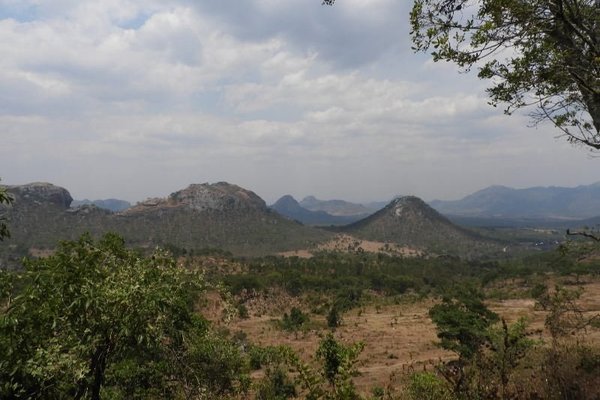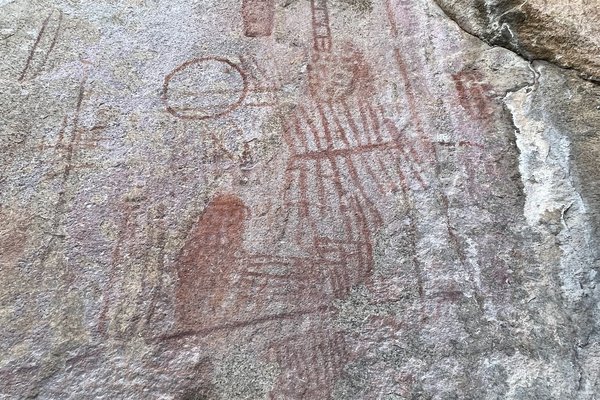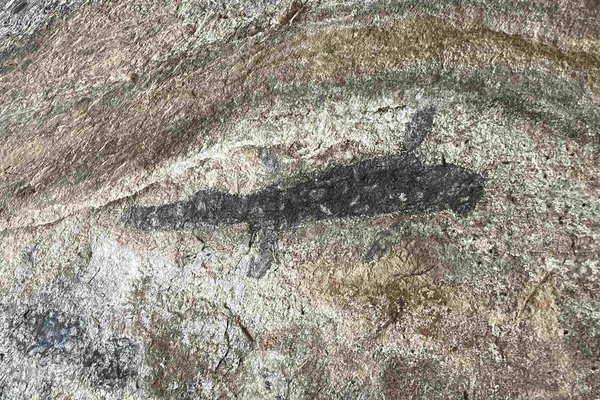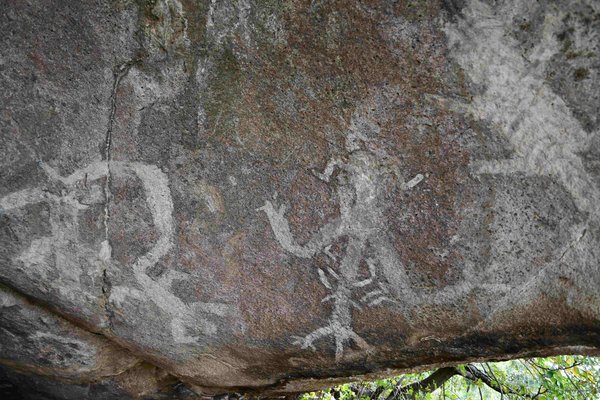Malawi
Chongoni Rock Art
The Chongoni Rock Art Area consists of a cluster of 127 sites that feature the richest concentration of rock art in Central Africa.
The paintings are found in rock shelters within granite formations. They reflect both the traditions of rock art of the BaTwa hunter-gatherers and of Chewa agriculturalists from the Late Stone Age til the 20th century. The paintings are connected to living traditions: funeral rites, girls' initiation and rainmaking.
Community Perspective: the site can fairly easily be reached from the hub of Dedza, but it needs a drive on bad roads to access the paintings and a guide to explain them. Only a few panels are open to tourists: Joseph visited Chentcherere and Mphunzi in 2014, while Randi, in 2022, was only allowed access to the latter.
Site Info
Official Information
- Full Name
- Chongoni Rock Art Area (ID: 476)
- Country
- Malawi
- Status
-
Inscribed 2006
Site history
History of Chongoni Rock Art
- 2006: Inscribed
- Inscribed
- 2005: Referred
- legal protection
- Type
- Cultural
- Criteria
- iii
- vi
Links
- UNESCO
- whc.unesco.org
- Official
-
- malawitourism.com — Malawi Tourism Guide
All Links
UNESCO.org
- whc.unesco.org — whc.unesco.org/
Official Website
- malawitourism.com — Malawi Tourism Guide
Community Information
- Community Category
- Archaeological site: Rock Art
Travel Information
Recent Connections
-
Bantu peoples
Chewa
-
Built in the 5th century BC
earliest archaeological remains -
UNESCO Intangible Cultural Heritage Lists
Gule Wamkulu
Connections of Chongoni Rock Art
- Geography
-
-
Zambezi basin
Nearly all of Malawi is within the Zambezi basin
-
- Trivia
-
-
Minority communities
Chewa -
Role of Women
"Much of the rock art seems to have been carried out by women."
-
- History
- World Heritage Process
-
-
First sites filling gaps cited by ICOMOS
African rock art 2006
-
- Religion and Belief
-
-
Living indigenous religions
"Although the Chongoni sites are still used for initiation, nyau and rain ceremonies, rock painting has ceased. " (AB) -
Secret Societies
Nyau secret society
-
- Human Activity
-
-
Hunter-gatherers
The rock art reflects the comparatively scarce tradition of farmer rock art, as well as paintings by BaTwa hunter-gatherers who inhabited the area from the late Stone Age. (official description) -
Pictographs
-
Pygmy Peoples
Bathwa or Akafula, "pygmy-like people", painted some of the rock art
-
- WHS on Other Lists
-
-
UNESCO Intangible Cultural Heritage Lists
Gule Wamkulu
-
- Timeline
-
-
Built in the 5th century BC
earliest archaeological remains
-
News
No news.
Community Reviews
Show full reviews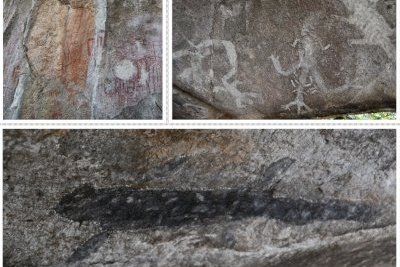
Visit in July 2022.
This place is rather remote and gets very few visitors.
The rock art of Chongoni is of international importance because it has large and well-preserved rock paintings sites belonging to rare African rock art traditions: by Chewa farmers and by the hunter gathering BaTwa Pygmies. The Chongoni area contains some of the finest examples of Pygmy, rock arts in Africa and more than half of all of central Africa’s farmer rock art. Chongoni has one of the world’s greatest concentrations of rock art known to have been made by women.
They have discovered 127 different panels, but they believe there are more. At the time we visited, only one site was open for public, the Mphunzi site. We picked up a guide at the Dedza pottery and lodge. He drove with us out to the site, about 45 minutes’ drive mostly on a bad dirt road, but a scenic ride through rural villages.
The site consists of 7 panels. We first hiked up to panel 7, one km uphill. This is the youngest site with white paintings about 500 - 2000 years old. The images symbolize rituals with animal’s masks. Many images are clearly visible, but others are faded. These paintings were made by the Chewa agriculturalist. Amongst the white figures, there was one figure in black color, which is quite rare. These people are stilling living in the area and rituals/ceremonies are still taking place in the rock shelters.
This …
Keep reading 0 comments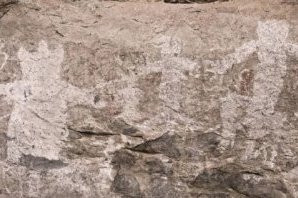
Usually this place isn't high on the list of travelers to Malawi. My visit was part of a safari tour that took me from Lake Malawi through Zambia to Botswana and it had this as a scheduled stop. The driver stated he rarely goes there and only because I had selected the "extensive" tour. From the only road across the country there is a road leading south that goes to the rock art. It is clearly signed, not that I think you'll be driving on your in Malawi but it's not unheard of. The closer you get to the sites the worse the road gets, eventually just dirt roads and little villages. That might explain why most safari tours avoid it. After just one site I told the driver I am not really interested, which of course in hindsight seems crazy BUT I stay with my rating that they are utterly garbage. While I'm not a fan of rock art in general, (I mean, who is?) I have seen my share of good ones. Colorful tigers in caves, various animals to show the changes to the landscape over time, even just traditional stuff is ok with me. However, what you see at Chongoni are very primitive drawings that seem to mainly focus on the local customs. Immediately that makes me thing why it's supposed to have a global impact, and honestly I'm not sure it's unique. There must be very similar rock art sites across southeast or just southern Africa …
Keep reading 0 comments
First off, Malawi is well deserving of its reputation as "the warm heart of Africa," with welcoming, friendly people and some beautiful scenery. (I did see another piece of unofficial but edgier tourist literature that touted Malawi as "more than Madonna's children.")
However, Malawi's location, surrounded on three sites by Mozambique places it off the usual safari, African tourist track. It's not difficult to get to, just off the beaten path, so you have to make Malawi a destination and want to visit. This world heritage site is in the same category--not hard to get to but it does take some specific effort (and patience).
I visited two of the three Chongoni rock art sites that are open to the public (i.e., accessible without unsafe hiking into the bush, for several hours with a guide, if you can find one able to take on the task) in August 2014, from Dedza, a busy transport center in the (thankfully) cool highlands. Dedza is easy to reach by bus or car from either of the big cities in Malawi, Lilongwe or Blantyre. Once in Dedza, to get to the rock art sites, unless you have your own transport you must arrange a car and driver/guide. Any of the staff at the lodges should be able to do this. My cost for a full day was about $65.
There is a dirt road to the sites, full of pot holes, ruts and gullies used mostly by heavy sawmill trucks, which I imagine doesn't …
Keep reading 0 comments
